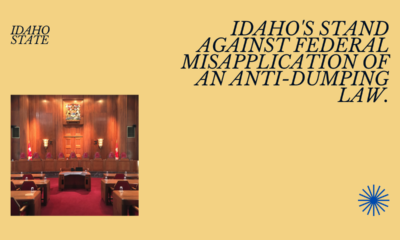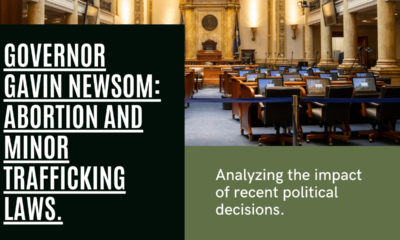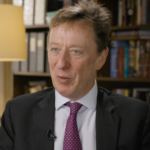Civilization
The Hockey Stick Trial: Science Dies in a DC Courtroom
Michael Mann, author of the Hockey Stick, won a defamation case in Washington, D.C. He won; science lost. The truth does not support him.

“Science,” wrote the philosopher Karl Popper, “is one of the very few human activities – perhaps the only one – in which errors are systematically criticised and fairly often, in time, corrected.” The sub-title of Popper’s 1963 book Conjectures and Refutations, in which he argued that science progresses through inspired conjectures checked by attempts to refute them through criticism, is “The Growth of Scientific Knowledge.” Now, a six-person jury in Washington, DC has refuted Popper’s formulation of the uniqueness of science, finding in favor of climate scientist Michael Mann in the defamation suit he brought against Rand Simberg and Mark Steyn dating back to 2012.
Central to Mann’s case was his attempt to reconstruct global temperature over the previous millennium – the iconic “hockey stick” graph. The graph shows global temperatures purportedly falling for centuries and suddenly shooting upwards with the advent of the Industrial Revolution. Mann’s hockey stick representation was derived principally from selected tree ring data based on the assumption that tree rings constitute accurate proxies for temperature and are not contaminated by confounding factors such as rainfall, seasonal variability, and levels of carbon dioxide in the atmosphere. The results that Mann produced are also sensitive to decisions on and application of statistical techniques.
There can be little doubt of the hockey stick’s historic importance in the development and propagation of what became the dominant scientific paradigm of climate change. In 2001, the hockey stick was given star billing in the Intergovernmental Panel on Climate Change’s (IPCC) Third Assessment Report, where it appeared twice in the synthesis report, twice more in a diagram combining past and future temperature change, and again on the third page of the Working Group I Summary for Policy Makers. Gerald North, a leading atmospheric physicist at Texas A&M University and one of the most cited authors in the geosciences, had no doubt as to the significance of the hockey stick. “The planet has been cooling slowly until one hundred and twenty years ago, when, bam! It jumps up,” North told Science in 2000. “We’ve been breaking our backs on [greenhouse] detection, but I found the one-thousand-year records more convincing than any of our detection studies.” For Mann, the hockey stick was his ticket to climate super-stardom.
In keeping with Popper’s premise about science, however, Mann’s hockey stick aroused criticism from its first appearance. In response, Mann engaged in distinctly anti-Popperian efforts to suppress all criticism of the hockey stick and discussion of rival temperature reconstructions that might raise awkward questions about its scientific validity. A rival reconstruction by fellow paleo-climatologist Keith Briffa, for example, derived from tree ring data obtained from northern Canada and Siberia, showed a noticeable decline in temperatures over the latter part of the 20th century – opening up a divergence with the instrumental record. If tree rings suggested declining temperatures when temperatures were actually rising, then how could climate scientists put any confidence in tree rings as thermometers? Up could really mean down.
Briffa then wrote a paper for Science comparing the rival reconstructions. As we know from the Climategate emails leaked in 2009, Mann contacted the editor of Science. “Better that nothing appear, than something unacceptable to us,” he wrote, copying in one of his co-authors, Raymond Bradley. After Science published Briffa’s paper, Mann tried to patch things up. “Thanks for all the hard work,” he emailed colleagues. The sentiment didn’t go down well with Bradley. “Excuse me while I puke,” Bradley emailed Briffa.
Such shenanigans are small beer compared to the surgery undertaken on the graphs of proxy reconstructions showcased in the IPCC’s Third Assessment Report. To deal with Briffa’s question-inducing temperature decline, Mann, as lead chapter author, and a tight-knit team resorted to the simple expedient of truncating adverse data that could serve as a “potential distraction/detraction,” Mann explained to his colleagues, and thereby hiding the temperature decline shown by Briffa’s proxies when temperatures were rising. The gambit also involved using actual temperature data to smooth the proxy curves in what became known as “Mike’s Nature trick,” something Mann had done previously in a paper submitted to that journal.
There was a more fundamental problem with the construction of the hockey stick. Analysis conducted by Canadians Steve McIntyre, a former mining engineer with a strong grounding in mathematics, and environmental economist Ross McKitrick using an algorithm based on a fragment of Mann’s computer code, found that running statistically trendless “red noise” produced hockey stick shapes 99 percent of the time. In other words, you could get hockey sticks from random junk data if you had enough of it.
Mann included in his proxy data set a series of bristlecone and foxtail pines from the western United States that had been selected by researcher Donald Graybill to study the possible effects of carbon dioxide fertilization on tree growth. To get the hockey stick from the data, Mann needed both the algorithm and Graybill’s tree ring data. Did Mann know what he was doing? Inside his directory of North American proxy data, Mann had a folder which he had labelled BACKTO_1400-CENSORED containing the North American data except all sixteen of the Graybill series. When the numbers from the CENSORED folder were run, the blade of the hockey stick disappeared.
While the blade of the hockey stick showed a sharp, anomalous rise in global temperature coinciding with the onset of the Industrial Revolution, its shaft also performed a critical function in radically revising the previously accepted climatological record by showing a steady decline in temperatures from the end of the first millennium. What previous generations of climatologists called the Medieval Warm Period had disappeared.
The Medieval Warm Period presented a twofold problem to the new climate change orthodoxy. It implied a much greater amplitude of natural variability beyond the bounds posited by the new scientific consensus of human-driven climate change, and it challenged the catastrophist narrative of global warming. If the prosperity of the Middle Ages and Viking settlement of Greenland occurred during an extended period of unusual warmth, then modern societies, too, could survive and prosper in a period of rising temperature.
In written congressional testimony in 2011, the climate scientist John Christy recalled discussions on the preparation of the Third Assessment Report when he pressed for inclusion of the findings of a 1998 paper in which Greenland ice-borehole temperatures provide a 20,000-year reconstruction. “Their result indicated a clear 500-year period of temperatures, warmer than the present, centered about 900 AD,” Christy testified. Despite – or, perhaps, because – of the importance of the paper in contradicting the hockey stick, the Third Assessment Report ignored the paper altogether.
Mann went further in a 2008 paper that presented a 2,000-year temperature reconstruction. The reconstruction was derived from sediments from Lake Korttajarvi in Iceland analyzed in a paper by the Finnish geologist Mia Tiljander. But Mann’s reconstruction inverted the Tiljander proxies, so warming became cooling and cooling became warming. According to Matti Saarnisto, one of Tiljander’s co-authors, the Medieval Warm Period was shown in a mirror image. In an email he’d received from Bradley, who despite his previous experience was still one of Mann’s co-authors, a large group of researchers had been handling extensive material and “at some point it happened that this graph was turned upside down.” Was this done on purpose or by mistake? “It has been turned upside down twice in Science, and now I doubt if it can be a mistake any more,” Saarnisto said, adding that the authors belong to a group “skeptical about this Medieval Warm Period and have tried to hide it to some extent.”
***
Mann’s defamation suit revolved around two issues. The first relates to Simberg and Steyn linking the investigation of Mann at Penn State, where he was professor of meteorology, to the university’s investigation and cover-up involving football coach and convicted child rapist Jerry Sandusky. Penn State president Graham Spanier was later convicted of child endangerment for his role in the Sandusky cover-up. As Steyn told the court in his opening statement:
the same scoundrel who protected Sandusky also protected Michael Mann. So, we’re not comparing Mann with Sandusky; we’re comparing the investigation of Mann with the investigation of Sandusky – because both investigations were controlled by the same chap: a corrupt convicted criminal called Graham Spanier.
Of the two defendants, Simberg’s language was the less delicate and more direct. As Steyn told the jury, quoting directly from his original piece, “I’m not sure I would have extended that metaphor all the way into the locker room showers with quite the zeal Mr. Simberg does, but he has a point,” distancing himself from Simberg’s statement that Mann could be regarded as the Jerry Sandusky of climate science.
The second issue relates to Simberg and Steyn describing Mann’s hockey stick as fraudulent. Though this was less inflammatory than the linkage made between Mann and Sandusky via Penn State’s respective investigations into their conduct, the jury believed that it was the greater offense. It imposed just $1,000 in punitive damages on Simberg but $1 million – one thousand times more – on Steyn. (The jury awarded Mann a dollar each from Simberg and Steyn to compensate him for damage to his reputation.) The massive differential in punishments the jury meted out to the two defendants can only be explained by the jury’s political bias. Steyn has a high profile as one of the most accomplished of conservative commentators. Evidently, the DC jury decided to make an example of Steyn and discourage any public questioning of today’s consensus of human-caused climate change.
In his opening statement, Steyn argued that it is not for the courts to adjudicate science. “A scientific theorem that requires validation by a courtroom verdict is not science at all,” Steyn argued. In principle, a court should be able to assess whether evidence used to make a scientific claim has been knowingly distorted, omitted, concealed or, in some other way, manipulated to produce a desired result. After all, fraud is not limited to theft but includes the tort of fraudulent misrepresentation.
Mann’s lawsuit demonstrates that the courts – at least, a court in the nation’s capital with politically biased jurors – are not capable of objective evaluation. Such cases also involve federal rules on the admissibility of evidence proffered by expert witnesses and the Daubert standard for scientific evidence. In a 39-page report, climate scientist Judith Curry gave her opinion that it is “reasonable” to have referred to the hockey stick in 2012 as “fraudulent” in the sense that “aspects of it are deceptive and misleading.”
However, Judge Alfred S. Irving excluded Curry’s report, which catalogued the manipulations of data to get a hockey stick shape and quoted severe criticisms of the hockey stick made even by climate scientists supportive of the climate-change consensus (most of these made privately). For his exclusion, the judge cited grounds that “the methodologies of the expert must be grounded in the scientific method, such that another person with similar expertise could replicate them.” Ruling on the inadmissibility of her testimony, Judge Irving said: “To wit, her expert report does not contain any explanations of her methodologies, making it impossible for the Court to find her testimony reliable.” There is little theoretical difference between cataloguing evidence to determine fraudulent misrepresentation in financial and commercial cases and evidence to assess scientific fraud; it would be absurd to require fraud investigators to set out their methodologies and expect different investigators to compile identical reports.
The trial closed with Mann’s counsel, John Williams, making a naked appeal to the jurors’ political prejudices. Williams urged the jury to award punitive damages so that no one will dare engage in “climate denialism” – just as Donald Trump’s “election denialism” needed to be suppressed. “In 41 years of trying cases to juries,” John Hinderaker wrote on the Powerline blog, “I have never heard such an outrageously improper appeal.”
Steyn related in his opening statement that Mann had chosen not to sue him for describing the hockey stick as fraudulent in any of the English-speaking jurisdictions lacking the free speech protections of the First Amendment. The upshot of Mann’s victory, Steyn warned, would be that “you cannot call his hockey stick a fraud in the United States, but you can in all the countries that chose, unlike you rebellious guys, to remain within the British Empire.”
This points to the biggest issue at stake in the trial. On the northeast wall of the Jefferson Memorial in Washington, is carved a short extract that Thomas Jefferson had drafted for a bill on establishing religious freedom. Its preamble provides the philosophical justification for why the First Amendment is ranked first:
truth is great and will prevail if left to herself; that she is the proper and sufficient antagonist to error, and has nothing to fear from the conflict unless by human interposition disarmed of her natural weapons, free argument and debate; errors ceasing to be dangerous when it is permitted freely to contradict them.
As Popper argued, free argument and debate are not only essential for the advance of scientific knowledge. They also constitute the fundamental requirement for the maintenance of a constitutional republic.
This article was originally published by RealClearEnergy and made available via RealClearWire.
Rupert Darwall is a senior fellow of the RealClear Foundation and author of The Folly of Climate Leadership: Net Zero and Britain’s Disastrous Energy Policies.
-

 Education3 days ago
Education3 days ago‘Grading for Equity’: Promoting Students by Banning Grades of Zero and Leaving No Class Cut-Ups Behind
-

 Civilization5 days ago
Civilization5 days agoEarth Day Should Celebrate U.S. Progress & Innovation
-

 Family2 days ago
Family2 days agoIdaho defends against abortion mandate
-

 Civilization3 days ago
Civilization3 days agoNewsom plays silly abortion politics
-

 Education5 days ago
Education5 days agoThe Intifada Comes to America. Now What?
-

 Constitution1 day ago
Constitution1 day agoPresidential immunity question goes to SCOTUS
-

 Civilization4 days ago
Civilization4 days agoEarth Day – part of cultural Marxism
-

 Civilization4 days ago
Civilization4 days agoWaste of the Day: China Still Owes Over $1 Trillion to American Bondholders










